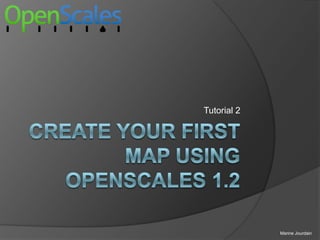
02 create first-map
- 1. Create your first map using openscales 1.2 Tutorial 2 Marine Jourdain
- 2. Prerequisites This tutorial begins where ”Configure your first project using OpenScales” (tutorial 1) left off. 2
- 3. What you obtain with this tutorial 3
- 4. Code to obtain the map 4 <?xml version="1.0" encoding="utf-8"?> <s:Applicationxmlns:fx="http://ns.adobe.com/mxml/2009" xmlns:s="library://ns.adobe.com/flex/spark" xmlns:mx="library://ns.adobe.com/flex/mx" minWidth="955" minHeight="600" xmlns:os="http://openscales.org"> <fx:Declarations> </fx:Declarations> <os:Map id="fxmap" width="500" height="600" zoom="12" centerLonLat="4.83212,45.75781" x="100" y="100"> <os:Mapnik name="base" isBaseLayer="true" proxy="http://www.openscales.org/proxy.php?url=" /> <os:MousePosition x="10" y="{fxmap.height-20}" displayProjection="EPSG:4326"/> <os:DragHandler/> <os:ClickHandler/> <os:WheelHandler/> </os:Map> <os:ControlPanel x="110" y="110" width="140" title="Navigation"> <os:PanComponent map="{map}"/> <mx:HBox width="100%" paddingLeft="5" paddingRight="5"> <os:ZoomComponent map="{map}"/> <mx:Spacer width="100%"/> <os:ZoomBoxComponent map="{map}" width="32" height="32"/> </mx:HBox> </os:ControlPanel> <fx:Script> <![CDATA[ importorg.openscales.core.Map; [Bindable] privatevar map:Map = null; privatefunctioninitMap():void { map = fxmap.map; } ]]> </fx:Script> </s:Application>
- 5. The .mxml file at the beginning 5 <?xml version="1.0" encoding="utf-8"?> <s:Applicationxmlns:fx="http://ns.adobe.com/mxml/2009" xmlns:s="library://ns.adobe.com/flex/spark" xmlns:mx="library://ns.adobe.com/flex/mx" minWidth="955" minHeight="600"> <fx:Declarations> </fx:Declarations> </s:Application>
- 6. Add a namespace 6 <?xml version="1.0" encoding="utf-8"?> <s:Applicationxmlns:fx="http://ns.adobe.com/mxml/2009" xmlns:s="library://ns.adobe.com/flex/spark" xmlns:mx="library://ns.adobe.com/flex/mx" minWidth="955" minHeight="600" xmlns:os="http://openscales.org"> <fx:Declarations> </fx:Declarations> </s:Application> Now, “os” namespace is linked to the OpenScales-fx library.
- 7. Create a map The following source code adds a map to your application. id is the unique identifier of the FxMap(here: fxmap) width and height restrict the size of the map zoom sets the zoom level when the application starts centerLonLat represents the coordinates where the map will be centered to. They should be in the same projection as the base layer. x and y determine the position of the map in the application In the following page you will see a graphic explanation of those parameters 7 <os:Map id="fxmap" width="500" height="600" zoom="12" centerLonLat="4.83212,45.75781" x="100" y="100"> </os:Map>
- 8. Create a map 8 Application width y Map width x Map height Application height centerLonLat coordinates
- 10. Others OSM layers exists : Cycle Map, Osmarender which are maps based on OSM datas but with other rendering rules.
- 11. isBaseLayer parameter tells if the layer should be used as the base layer. A map should at least have one base layer.
- 12. proxy parameter is not mandatory but may prevent security errors due to non valid crossdomain policy on the targeted server whichis the case with OSM servers.Add an Open Street Map (OSM) layer 9 <os:Mapnik name="base" isBaseLayer="true" proxy="http://www.openscales.org/proxy.php?url=" />
- 13. Example with an OGC layer: Web Feature Service (WFS) The Open Geospatial Consortium defines several protocols like WFS, WMS… You can find many examples with OGC layer in OpenScales-fx-example sources. Here is an example that provides a Web Feature Service layer as a base layer. Note: to well visualise the example, change the coordinates of the centerLonLat Map parameter (centered on the USA) and set the zoom to 3. 10 <os:WFS name="Topp States (WFS)" url="http://openscales.org/geoserver/wfs" typename="topp:states" projection="EPSG:4326" version="1.0.0" isBaseLayer="true" style="{Style.getDefaultSurfaceStyle()}"> </os:WFS> zoom="3" centerLonLat="-100.10929,40.48437"
- 14. <os:Mapnik name="Mapnik" isBaseLayer="true" proxy="http://openscales.org/proxy.php?url="/> <os:KMLurl="http://code.google.com/intl/fr/apis/kml/documentation/KML_Samples.kml" proxy="http://openscales.org/proxy.php?url=" numZoomLevels="20" style="{Style.getDefaultLineStyle()}"/> Use several layers in one single map Example : add an OSM base layer and a KML layer The KML layer is not set as a base layer so that it will come over the OSM layer. On the example, Mapnik is the baselayer, and the KML layer is visible thanks to the 3 markers. 11
- 15. Security OpenScales allows you to use security manager to access one or more layers. Here is an example with a layer from the French National Geographic Institute (IGN) portal (http://geoportail.fr). It uses an OGC protocol: Wep Map Service – Cached layer 12 <os:IGNGeoRMSecuritykey="xxxxxxxx" layers="ORTHOPHOTOS" proxy="http://openscales.org/proxy.php?url="/> <os:WMSC id="ortho" name="ORTHOPHOTOS" url="http://wxs.ign.fr/geoportail/wmsc" layers="ORTHOIMAGERY.ORTHOPHOTOS" format="image/jpeg" isBaseLayer="true" resolutions="39135.75,19567.875,9783.9375,4891.96875,2445.984375,2048,1024,512,256,128,64,32,16,8,4,2,1,0.5,0.25,0.125,0.0625" projection="IGNF:GEOPORTALFXX" minZoomLevel="5" maxZoomLevel="17" maxExtent="-1048576,3670016,2097152,6815744" exceptions="text/xml"/>
- 16. Add the coordinates of the mouse position Coordinates are displayed in the specific system of projection that you want to use. In the following example (add it into the <os:Map> tag) the projection used is the EPSG:4326 (http://spatialreference.org/ref/epsg/4326/). x and y are the position (in pixel) where the coordinates will be displayed on the map. 13 Fxmap.height <os:MousePosition x="10" y="{fxmap.height-20}" displayProjection="EPSG:4326"/>
- 17. Add mouse controls Several mouse controls are available: zoom using mouse wheel (WheelHandler) various controls with the click (ClickHandler) Move the map using drag and drop (DragHandler) … This will allow you to move the map, clic, zoom with the mouse wheel. It should be inserted into <os:Map> tag. 14 <os:DragHandler/> <os:ClickHandler/> <os:WheelHandler/>
- 18. Add a control panel To display a panel, you have to insert the following code after the </os:Map> tag. This example adds a panel containing a pan component, a zoom component and a zoom box component. Warning : this requires a small Action Script code. See the following slide. 15 width <os:ControlPanel x="110" y="110" width="140" title="Navigation"> <os:PanComponent map="{map}"/> <mx:HBox width="100%" paddingLeft="5" paddingRight="5"> <os:ZoomComponent map="{map}"/> <mx:Spacer width="100%"/> <os:ZoomBoxComponent map="{map}" width="32" height="32"/> </mx:HBox> </os:ControlPanel>
- 19. Add the needed Action Script code for the control panel After the </os:ControlPanel> tag, add: We find: fxmap: the identifier of the FxMap seen when you create a map The initialization of map for the control panel You also have to specify that initMap() have to be called when the application is ready: 16 <fx:Script> <![CDATA[ importorg.openscales.core.Map; [Bindable] privatevar map:Map = null; privatefunctioninitMap():void { map = fxmap.map; } ]]> </fx:Script> <os:Map id="fxmap" <os:PanComponent map="{map}"/> <s:Applicationxmlns:fx="http://ns.adobe.com/mxml/2009" xmlns:s="library://ns.adobe.com/flex/spark" xmlns:mx="library://ns.adobe.com/flex/mx" minWidth="955" minHeight="600" xmlns:os="http://openscales.org" creationComplete="initMap();">
- 20. How to launch the Flash application Click on the icon of your flash builder environment to launch your application. In the Run as window, choose Web application or Desktop Application, depending on what you choose when you configured your project. 17
- 21. Here you are Right now, you’re able to start building your OpenScales maps. Find sources on: http://www.openscales.org/tutorials/ 18